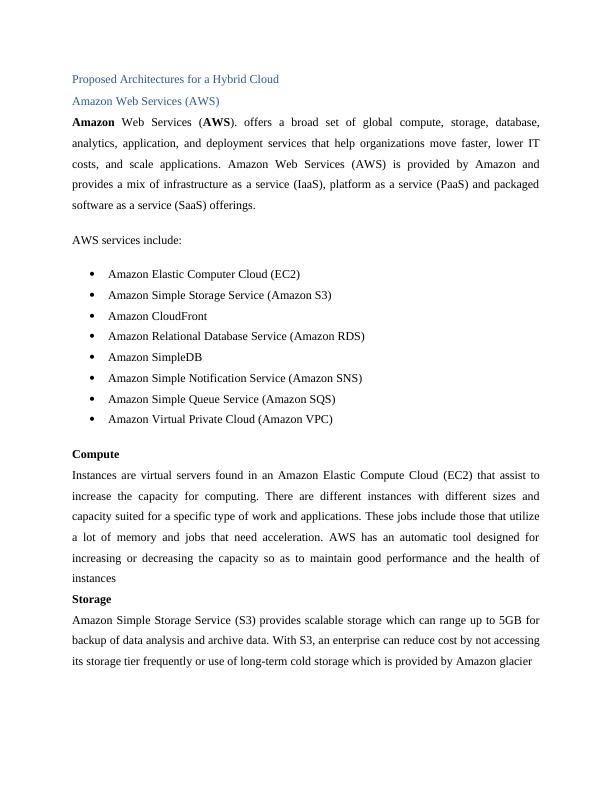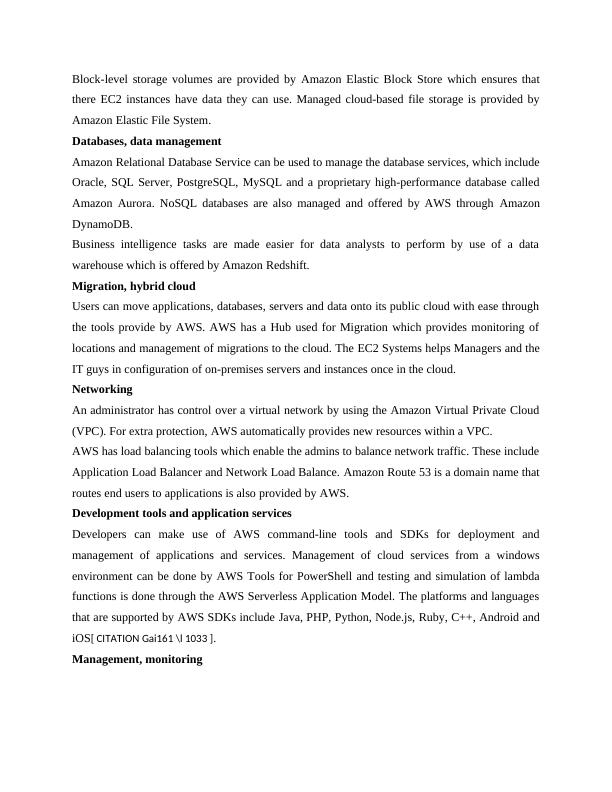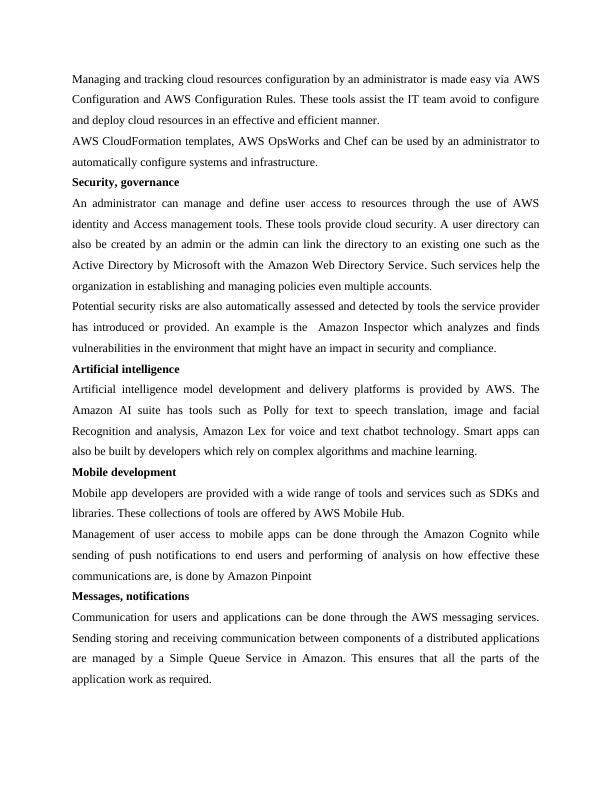Ask a question from expert
Development of Cloud Computing - PDF
15 Pages4861 Words117 Views
Added on 2021-05-30
Development of Cloud Computing - PDF
Added on 2021-05-30
BookmarkShareRelated Documents
Abstract Cloud Computing is the latest technological development that is in demand. It has led to thestorage of data and made it easy for organizations and companies to share resources whichinclude services networks applications and servers. These resources can be accessed with easeand minimal interaction with the cloud service providers. Development of cloud computing hasits own challenges and some include developing new cloud technology software. The majorchallenges are fact are due to the complexity of cloud applications when building due to thedifferent service providers. Each service provider has their own infrastructure and this makes itdifficult to create an application that will be able to integrate with all the providers. Cloudcomputing applications demand that they be updated constantly to fit in with the ever-changingarchitecture, design, testing and evolution of software. Cloud computing architectures differ in abig way than the traditional systems and applications that we are used to. Most challenges arearchitecture and infrastructure related or on services provided by other cloud service providers.There is minimal support in terms of cloud architecture to ensure that the use of the cloudtechnology is done in an efficient and systematic way. For instance, it is reasonable to think thatsoftware architectures need to be described in a different way if they are deployed on the cloud.Therefore, it is necessary to provide an architectural support to their project and means to modelthem and capture important elements regarding the Cloud Computing paradigm.

Proposed Architectures for a Hybrid CloudAmazon Web Services (AWS)Amazon Web Services (AWS). offers a broad set of global compute, storage, database,analytics, application, and deployment services that help organizations move faster, lower ITcosts, and scale applications. Amazon Web Services (AWS) is provided by Amazon andprovides a mix of infrastructure as a service (IaaS), platform as a service (PaaS) and packagedsoftware as a service (SaaS) offerings.AWS services include: Amazon Elastic Computer Cloud (EC2)Amazon Simple Storage Service (Amazon S3)Amazon CloudFrontAmazon Relational Database Service (Amazon RDS)Amazon SimpleDBAmazon Simple Notification Service (Amazon SNS)Amazon Simple Queue Service (Amazon SQS)Amazon Virtual Private Cloud (Amazon VPC)ComputeInstances are virtual servers found in anAmazon Elastic Compute Cloud (EC2) that assist toincrease the capacity for computing. There are different instances with different sizes andcapacity suited for a specific type of work and applications. These jobs include those that utilizea lot of memory and jobs that need acceleration. AWS has an automatic tool designed forincreasing or decreasing the capacity so as to maintain good performance and the health ofinstancesStorageAmazon Simple Storage Service (S3) provides scalable storage which can range up to 5GB forbackup of data analysis and archive data. With S3, an enterprise can reduce cost by not accessingits storage tier frequently or use of long-term cold storage which is provided by Amazon glacier

Block-level storage volumes are provided by Amazon Elastic Block Store which ensures thatthere EC2 instances have data they can use. Managed cloud-based file storage is provided byAmazon Elastic File System.Databases, data managementAmazon Relational Database Service can be used to manage the database services, which includeOracle, SQL Server, PostgreSQL, MySQL and a proprietary high-performance database calledAmazon Aurora. NoSQL databases are also managed and offered by AWS through AmazonDynamoDB.Business intelligence tasks are made easier for data analysts to perform by use of a datawarehouse which is offered by Amazon Redshift.Migration, hybrid cloudUsers can move applications, databases, servers and data onto its public cloud with ease throughthe tools provide by AWS. AWS has a Hub used for Migration which provides monitoring oflocations and management of migrations to the cloud. The EC2 Systems helps Managers and theIT guys in configuration of on-premises servers and instances once in the cloud.NetworkingAn administrator has control over a virtual network by using the Amazon Virtual Private Cloud(VPC). For extra protection, AWS automatically provides new resources within a VPC.AWS has load balancing tools which enable the admins to balance network traffic. These includeApplication Load Balancer and Network Load Balance. Amazon Route 53 is a domain name thatroutes end users to applications is also provided by AWS.Development tools and application servicesDevelopers can make use of AWS command-line tools and SDKs for deployment andmanagement of applications and services. Management of cloud services from a windowsenvironment can be done by AWS Tools for PowerShell and testing and simulation of lambdafunctions is done through the AWS Serverless Application Model. The platforms and languagesthat are supported by AWS SDKs include Java, PHP, Python, Node.js, Ruby, C++, Android andiOS[ CITATION Gai161 \l 1033 ].Management, monitoring

Managing and tracking cloud resources configuration by an administrator is made easy via AWSConfiguration and AWS Configuration Rules. These tools assist the IT team avoid to configureand deploy cloud resources in an effective and efficient manner.AWS CloudFormation templates, AWS OpsWorks and Chef can be used by an administrator toautomatically configure systems and infrastructure.Security, governanceAn administrator can manage and define user access to resources through the use of AWSidentity and Access management tools. These tools provide cloud security. A user directory canalso be created by an admin or the admin can link the directory to an existing one such as theActive Directory by Microsoft with the Amazon Web Directory Service. Such services help theorganization in establishing and managing policies even multiple accounts.Potential security risks are also automatically assessed and detected by tools the service providerhas introduced or provided. An example is the Amazon Inspector which analyzes and findsvulnerabilities in the environment that might have an impact in security and compliance.Artificial intelligenceArtificial intelligence model development and delivery platforms is provided by AWS. TheAmazon AI suite has tools such as Polly for text to speech translation, image and facialRecognition and analysis, Amazon Lex for voice and text chatbot technology. Smart apps canalso be built by developers which rely on complex algorithms and machine learning.Mobile developmentMobile app developers are provided with a wide range of tools and services such as SDKs andlibraries. These collections of tools are offered by AWS Mobile Hub.Management of user access to mobile apps can be done through the Amazon Cognito whilesending of push notifications to end users and performing of analysis on how effective thesecommunications are, is done by Amazon PinpointMessages, notificationsCommunication for users and applications can be done through the AWS messaging services.Sending storing and receiving communication between components of a distributed applicationsare managed by a Simple Queue Service in Amazon. This ensures that all the parts of theapplication work as required.

End of preview
Want to access all the pages? Upload your documents or become a member.
Related Documents
Summary of Amazon EC2lg...
|13
|2756
|393
Cloud Computing Services Providers Assignmentlg...
|19
|2052
|68
Cloud Computing for DTGOVlg...
|14
|852
|73
Amazon Web Services (AWS) | Assignmentlg...
|4
|1024
|308
Cloud Service Providers: A Comparison of AWS, Microsoft Azure, Google Cloud Platform, and IBM Cloudlg...
|26
|3925
|310
DTGOV and Cloud Computing: Benefits and Implementationlg...
|23
|1070
|74